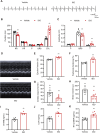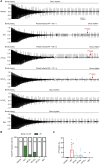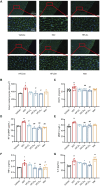Honey-fried licorice decoction ameliorates atrial fibrillation susceptibility by inhibiting the NOX2-ROS-TGF-β1 pathway
- PMID: 40771918
- PMCID: PMC12325216
- DOI: 10.3389/fphar.2025.1595111
Honey-fried licorice decoction ameliorates atrial fibrillation susceptibility by inhibiting the NOX2-ROS-TGF-β1 pathway
Abstract
Objective: Honey-fried licorice decoction (HFLD), a well-established traditional Chinese medicine, is widely used to treat atrial fibrillation (AF) in China. However, the specific cardioprotective mechanisms of HFLD in treating AF remain unclear. This study aimed to determine the efficacy of HFLD and validate the efficacy and mechanisms of action of HFLD in reducing AF susceptibility.
Methods: Serum oxidative stress biomarker levels of healthy controls and patients with paroxysmal AF were detected using enzyme-linked immunosorbent assay kits. The HFLD components were identified using ultra-performance liquid chromatography coupled with quadrupole time-of-flight mass spectrometry. Wistar rats were intraperitoneally injected with isoprenaline (5 mg/kg) for 2 weeks to construct an AF rat model. The effect of HFLD on AF was assessed with the transesophageal atrial pacing technique and histopathological analysis. The expression levels of NOX2-ROS-TGF-β1 signaling pathway related proteins were detected using Western blot and dihydroethidium staining.
Results: Our clinical trial verified that the expression of MDA increased, whereas SOD, CAT and GSH/GSSG ratio decreased in the serum of patients with paroxysmal AF compared with that in individuals with a normal sinus rhythm. Notably, HFLD treatment could reverse these imbalances. In rat experiments, HFLD was found to reduce oxidative stress and extracellular matrix deposition, thereby effectively reducing AF's induction rate and duration. Western blot analysis indicated that HFLD downregulated the expression of NOX2 and its regulatory proteins, leading to the inhibition of the downstream TGF-β1-SMAD3 signaling pathway.
Conclusion: HFLD may reduce AF susceptibility by inhibiting the NOX2-ROS-TGF-β1 pathway, potentially providing new perspectives on AF treatment.
Keywords: NOX2-ROS-TGF-β1 pathway; atrial fibrillation; fibrosis; honey-fried licorice decoction; oxidative stress.
Copyright © 2025 Qin, Wang, Chen, Tang, Zhi, Wu, Chen, Fu, Cai, Shen, Cao and Zhou.
Conflict of interest statement
The authors declare that the research was conducted in the absence of any commercial or financial relationships that could be construed as a potential conflict of interest.
Figures








Similar articles
-
Intravenous magnesium sulphate and sotalol for prevention of atrial fibrillation after coronary artery bypass surgery: a systematic review and economic evaluation.Health Technol Assess. 2008 Jun;12(28):iii-iv, ix-95. doi: 10.3310/hta12280. Health Technol Assess. 2008. PMID: 18547499
-
Acupuncture activates vagus nerve-macrophage axis and improves cardiac electrophysiology and inflammatory response in rats with atrial fibrillation via α7nAChR-JAK2/STAT3 pathway.J Integr Med. 2025 Jul;23(4):398-414. doi: 10.1016/j.joim.2025.06.002. Epub 2025 Jun 13. J Integr Med. 2025. PMID: 40562587
-
Vericiguat reduces atrial fibrillation recurrence by alleviating myocardial fibrosis via the TGF-β1/Smad2/3 pathway.PLoS One. 2025 Jul 18;20(7):e0328272. doi: 10.1371/journal.pone.0328272. eCollection 2025. PLoS One. 2025. PMID: 40680000 Free PMC article.
-
External electrical and pharmacological cardioversion for atrial fibrillation, atrial flutter or atrial tachycardias: a network meta-analysis.Cochrane Database Syst Rev. 2024 Jun 3;6(6):CD013255. doi: 10.1002/14651858.CD013255.pub2. Cochrane Database Syst Rev. 2024. PMID: 38828867 Free PMC article.
-
Study on the modulation of kidney and liver function of rats with diabetic nephropathy by Huidouba through metabolomics.J Ethnopharmacol. 2025 Jul 24;351:120136. doi: 10.1016/j.jep.2025.120136. Epub 2025 Jun 11. J Ethnopharmacol. 2025. PMID: 40513925
References
-
- Fowler E. D., Drinkhill M. J., Norman R., Pervolaraki E., Stones R., Steer E., et al. (2018). Beta1-adrenoceptor antagonist, metoprolol attenuates cardiac myocyte Ca2+ handling dysfunction in rats with pulmonary artery hypertension. J. Mol. Cell Cardiol. 120, 74–83. 10.1016/j.yjmcc.2018.05.015 - DOI - PMC - PubMed
LinkOut - more resources
Full Text Sources
Miscellaneous

